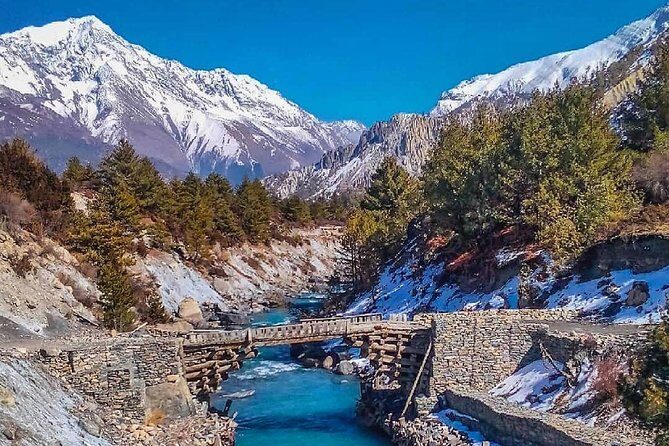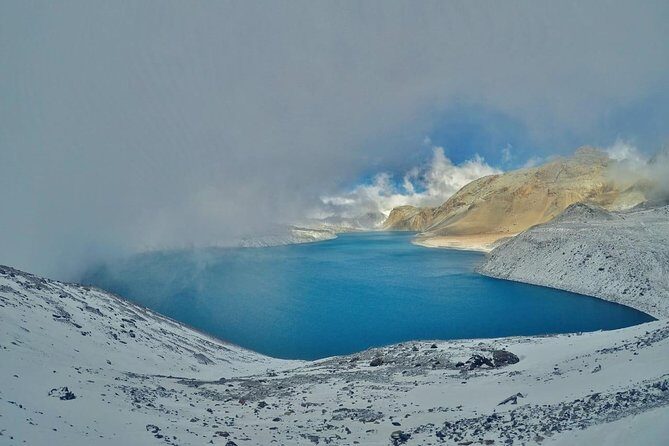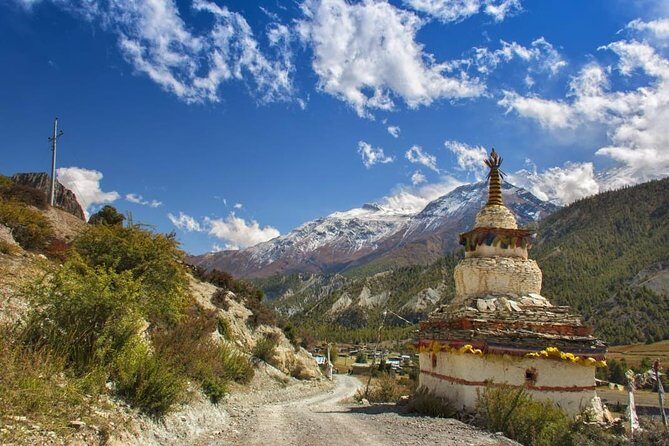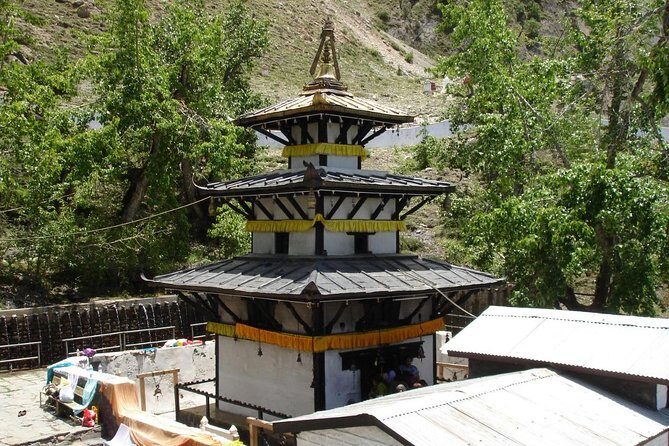Physical Address
304 North Cardinal St.
Dorchester Center, MA 02124
Physical Address
304 North Cardinal St.
Dorchester Center, MA 02124

Experience the stunning Annapurna Circuit with Tilicho Lake in a 17-day private guided trek. Enjoy expert guides, breathtaking views, and authentic Nepalese culture.
Planning a trek in Nepal? The Annapurna Circuit with Tilicho Lake is a standout choice for those looking for a well-rounded adventure that combines spectacular scenery, cultural insights, and manageable challenge. Offered as a private guided experience, this 17-day trek is designed to give you a comprehensive taste of the Himalayan beauty while ensuring comfort and guidance along the way.
What we love most about this trek? It’s the chance to explore iconic peaks like Annapurna, Manaslu, and Dhaulagiri, coupled with the opportunity to visit Tilicho Lake—one of the most mesmerizing high-altitude lakes in the world. Plus, the inclusion of a knowledgeable guide and porters adds a layer of ease and local insight that can make all the difference.
One thing to consider is that, at 17 days, this is a fair time commitment—though the pace is moderate, so you’ll want to be prepared for long walking days. This tour suits beginners with basic fitness and seasoned trekkers alike who want a well-supported experience, rich in natural beauty and cultural depth.

If you prefer having a local expert, these guided Kathmandu experiences could work well
Your adventure begins with a pickup from Kathmandu Airport, followed by a briefing about the trek—an excellent way to set expectations and ask questions. The drive to Besisahar, covering around 200 km, takes roughly 6-7 hours, giving you a chance to relax and soak in the rural Nepali landscape. Many travelers note the drive is scenic, with lush green valleys and mountain vistas gradually revealing themselves.
Starting the trek from Bhulbhule, just after Besisahar, means you’re immediately immersed in the Himalayan terrain. For those with limited time, there’s an option to begin from Manang after a drive, skipping the initial walking day, which some reviewers find convenient.
The trek kicks into gear as you head towards Chamje, passing villages like Bahundada and Syange. Expect a mix of river crossings, lush forests, and terraced farms. The trail is quite varied—an interesting blend of rocky ascents and gentle descents, with spectacular views of the Marsyangdi River below.
On Day 4, the trek to Dharapani involves crossing waterfalls and pine forests. Trekkers often comment on the peaceful vibe here, with the forest sounds and mountain streams serving as natural stress relievers. The walk is moderate, about 12 hours, but with good company and energy, it’s manageable.
Reaching Chame, the district headquarter of Manang, is a highlight. From here, views of Mt. Kailash and Annapurna peaks become more frequent, and the trail offers a mix of mountain panoramas and Rhododendron forests. Some trekkers mention that the road access means you could opt for a jeep part of the way if needed.
En route to Pisang, expect rugged terrain and stunning rock formations like Paungda Danda. Pisang itself offers both upper and lower sections, depending on your pace and preferences. The scenery here is jaw-droppingly dramatic, with steep cliffs and sweeping valley views.
The day in Manang is a crucial one—an acclimatization stop that helps prevent altitude sickness. Here, you’ll find a mix of natural beauty and cultural curiosity, with sights like Gangapurna Lake and local monasteries. Many reviewers appreciate the guide’s local insights, explaining the significance of various sites.
The hike to the upper part of Manang provides sweeping views of pinnacled peaks and glaciers, making it a worthwhile rest day. It’s also a chance to enjoy some authentic Nepali food, with many praising the hearty dal bhat and momos served in teahouses.
For a more personal experience, these private Kathmandu tours deliver individual attention
The trek toward Tilicho Lake involves a steep climb with incredible mountain vistas. The route takes you through small villages like Khangsar, with views of Annapurna, Gangapurna, and Tilicho Peaks. The highlight? Reaching Tilicho Lake early in the morning, a surreal, high-altitude body of water with a backdrop of towering mountains. Many reviewers say this is the most stunning part of the trek, with the lake’s shimmering surface reflecting the peaks.
Spending time at Tilicho Base Camp offers a unique perspective on the region’s geology and glaciers. The trail is challenging but rewarding, especially with the expert guidance that ensures safety during the altitude gains.
After Tilicho, the trail moves towards Yak Kharka, with views of Chulu West and East peaks. The terrain becomes more rugged and arid, especially as you approach Thorong Phedi. The landscape here can be quite stark, resembling a high-altitude desert, but the views of the surrounding peaks compensate.
The ascent to Thorong La begins early on Day 13; crossing this 5,416-meter pass is a major achievement. Expect cold, windy conditions, and be prepared for a strenuous, yet exhilarating, climb.
This is the “big day”—the highest point of the trek. The early start, around 4 AM, is necessary to beat the crowds and weather. The panoramic views from the pass are breathtaking, with peaks like Dhaulagiri and Nilgiri stretching out in all directions. Many travelers describe the crossing as tough but deeply satisfying, especially when you pause to enjoy your hot tea at the small tea shop at the top.
Descending from Thorong La, you’ll pass through the cold desert terrain before reaching the sacred Muktinath Temple, a revered pilgrimage site. The trail offers sweeping views of Nilgiri and Dhaulagiri mountains. From Jomsom, you have the option to fly or drive back to Pokhara, a scenic town known for its lakes and relaxed atmosphere.
Many reviews mention how convenient it is to fly from Jomsom, saving days of walking and giving you extra time to relax and explore Pokhara’s lakeside vibe.
The trip concludes with a drive back to Kathmandu, allowing plenty of time for shopping, sightseeing, and reflecting on your adventure. The farewell Nepali dinner is a fitting way to celebrate completing the trek, with hearty local dishes and a warm atmosphere.

Traveling in comfort and safety is clearly a priority here. The inclusion of all permits (like the TIMS and ACAP), accommodations, and meals means you’re free to focus on the experience rather than logistics. The use of local teahouses provides authentic stays, and many reviewers comment on the quality of food, describing it as hearty and filling—exactly what you need after a long day on the trail.
The guides are described as knowledgeable, often sharing stories and explaining the significance of landmarks. The porters are capable of carrying up to 20kg for two people, which means you can pack reasonably light and let the team handle the heavy lifting.
Timing is well-planned, with early mornings for the big ascents like Thorong La, and rest days to acclimatize. Many also appreciate the flexibility of optional activities, like flying instead of trekking from Jomsom, which can save both time and energy.
Pricing at $2,300 might seem steep at first glance, but considering it’s an all-inclusive package with guided support, permits, and accommodations, it offers good value for a hassle-free, immersive mountain experience. It’s ideal for travelers who want a guided, comfortable journey without sacrificing the authentic feel of Nepalese culture.

This trek is perfect for beginners with some hiking experience looking for a guided, supported adventure. It’s also a great choice for those who want to enjoy the spectacular scenery without the stress of planning logistics or managing permits.
If you’re someone who appreciates authentic cultural encounters, stunning mountain vistas, and a moderate challenge, this trip checks all those boxes.
However, if you’re seeking an ultra-remote, self-guided, or faster-paced adventure, you might find this tour a bit structured. The 17-day duration is ideal for acclimatization and enjoying the sights at a relaxed pace, making it less suitable for those with limited time or a desire for a quick trek.

This private guided trek offers a well-rounded experience of the Annapurna region, blending natural beauty, local culture, and manageable physical challenge. The inclusion of expert guides, porters, and all necessary permits means you can focus on enjoying the journey, not troubleshooting logistics.
The scenic highlights—Tilicho Lake, Thorong La, and the view of Himalayan giants—are worth every penny. Plus, the cultural stops and warm Nepali hospitality make this more than just a hike; it’s an adventure filled with stories, stunning vistas, and authentic moments.
For those who value smooth organization, expert guidance, and a chance to take in some of Nepal’s most iconic sights at a comfortable pace, this trek is a fantastic choice. It’s especially suited for first-timers who want a safe, supported experience but also for seasoned trekkers eager to explore quietly with knowledgeable guides.
If you’re ready to embrace the mountains with a trusted team, this trek offers excellent value and a memorable journey through Nepal’s Himalayan wonderland.
How long is the trek?
The trek lasts approximately 17 days, covering about 160-300 kilometers, depending on optional routes and transfers.
Is this trek suitable for beginners?
Yes, it’s considered moderate and suitable for those with basic fitness and some short hiking experience.
What’s included in the price?
All airport transfers, accommodations in Kathmandu, meals during the trek, permits, a licensed guide, porters, local SIM card, and some meals are included.
Can I fly back instead of walking from Jomsom?
Yes, many travelers opt to fly from Jomsom to Pokhara, saving days of walking and reducing fatigue.
What about altitude sickness?
The itinerary includes rest days and acclimatization at key points like Manang, helping reduce risks.
Are accommodations comfortable?
Staying in teahouses and lodges, most travelers find the facilities simple but adequate, with hearty meals prepared.
What’s the best time to do this trek?
While not specified here, the best seasons are generally Spring (March-May) and Autumn (September-November).
Is the trek physically demanding?
Moderate in difficulty, with some long days and high passes, but manageable with proper preparation.
What should I pack?
Layered clothing, sturdy hiking boots, a good sleeping bag, and essentials like sun protection and water bottles are recommended.
This Annapurna Circuit with Tilicho Lake guided trek delivers a thoughtful, comprehensive adventure, blending natural wonder and cultural richness with expert support. Whether you’re seeking your first high-altitude trek or adding another Himalayan chapter to your travels, it’s an experience worth considering.